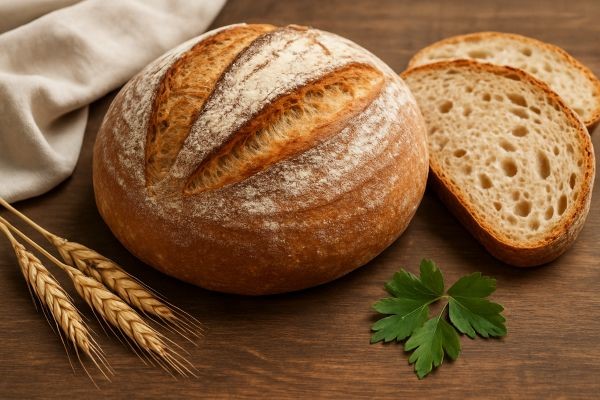Bread has been a staple food across cultures for centuries, but for people living with diabetes, it often feels like the enemy. Traditional loaves, loaded with refined flours and quick-digesting carbohydrates, can cause rapid spikes in blood sugar. However, one variety is gaining attention in diabetic communities worldwide—sourdough bread. What makes it different? The answer lies in the glycemic index (GI), fermentation, and how sourdough interacts with our bodies.
Understanding the Glycemic Index
The glycemic index is a scale that measures how quickly a food raises blood glucose levels after eating. Foods are ranked from 0 to 100:
- Low GI (55 or less): These foods release glucose slowly and steadily, making them friendlier for diabetics.
- Medium GI (56–69): Moderate impact on blood sugar.
- High GI (70 or more): These foods cause sharp spikes in blood glucose.
Most standard breads—white sandwich loaves, baguettes, and even some whole-grain options—fall into the high GI category. That means after eating them, blood sugar levels rise quickly, which is exactly what people with diabetes want to avoid.
Why Sourdough Bread Stands Out
Unlike conventional bread, sourdough bread is made using a natural fermentation process. Instead of commercial yeast, sourdough uses a “starter” made of flour and water that captures wild yeast and lactic acid bacteria. Over several hours (or even days), these microbes work together to ferment the dough.
This process changes the bread in unique ways:
-
Slower Digestion of Carbohydrates
-
-
- The acids produced during fermentation (especially lactic acid) alter the structure of starch molecules. This slows down how quickly your body breaks them into glucose.
-
-
Lower Glycemic Index
-
- Studies show that sourdough bread typically has a lower GI than white or whole-wheat bread. This means it causes a slower, steadier rise in blood sugar.
-
Improved Mineral Absorption
- Fermentation helps break down phytic acid, an antinutrient in grains that can block mineral absorption. That means more magnesium and zinc—important for blood sugar control—become available.
-
Enhanced Gut Health
- The lactic acid bacteria contribute to better gut microbiota balance, which has been linked to improved insulin sensitivity.
The Science Behind Sourdough and Blood Sugar
Several research studies have highlighted sourdough’s positive impact on glycemic control:
- University of Guelph Study (Canada): Found that participants who ate sourdough bread experienced lower blood sugar spikes compared to those who ate white or whole-wheat bread.
- Swedish Research: Reported that sourdough fermentation increased satiety (feeling full) and reduced insulin demand after meals.
- Nutritional Science Reviews: Suggest that fermentation produces bioactive compounds that improve glucose metabolism.
For diabetics, these effects are significant. Every meal becomes a balancing act between energy and blood sugar stability. Choosing sourdough bread over other breads can tip the balance in favor of more predictable glucose control.
Sourdough vs. Other Breads: A Quick Comparison
| Bread Type | Approx. GI Score | Impact on Blood Sugar | Notes |
| White Bread | 70–80+ | Sharp spike | Refined flour, minimal fiber |
| Whole Wheat Bread | 65–75 | Still high | More nutrients but still rapid absorption |
| Multigrain Bread | 60–70 | Moderate | Depends on grain blend |
| Sourdough Bread | 50–55 (avg.) | Gentle rise | Fermentation lowers GI and improves digestibility |
Note: Exact numbers can vary depending on recipe, flour type, and fermentation time.
Tips for Diabetics Choosing Sourdough
While sourdough bread offers many benefits, not all sourdough loaves are created equal. Here are some tips for selecting the right one:
-
-
Look for Authentic Fermentation
- True sourdough takes time to ferment. Some commercial loaves labeled “sourdough” may simply add vinegar or flavoring. Always check the ingredient list.
-
Choose Whole Grain or Low-Carb Versions
- Whole-grain sourdough provides more fiber, which further slows down carbohydrate absorption. Low-carb versions are even better for managing blood sugar.
-
-
Mind the Serving Size
-
-
- Even with a lower GI, sourdough bread still contains carbohydrates. Pair it with protein, healthy fats, or fiber-rich foods to further blunt glucose spikes.
-
-
Experiment with Timing
-
- Some diabetics find that eating bread earlier in the day (when insulin sensitivity is higher) results in better control.
Beyond Blood Sugar: Other Benefits of Sourdough
- Digestibility: Many people who struggle with regular bread report fewer digestive issues with sourdough.
- Rich Flavor: The tangy taste makes it a favorite for sandwiches, toast, and gourmet recipes.
- Natural Preservation: The acids help keep sourdough fresher longer without preservatives.
Why Diabetics Are Embracing Sourdough
For people with diabetes, choosing the right bread is about more than flavor—it’s about maintaining health, energy, and balance. Thanks to its natural fermentation, sourdough bread has a lower glycemic index, slower carbohydrate digestion, and added nutritional benefits compared to standard loaves. This makes it a smart, science-backed choice for better blood sugar management.
If you want the benefits of sourdough with the added assurance of ultra-low carbs, check out Low Carb Avenue’s sourdough bread. Crafted with just 3g net carbs per slice, 7g protein, and no added sugar, it combines the traditional art of fermentation with modern nutritional science—perfect for diabetics, keto followers, and anyone looking for bread that supports health without sacrificing taste.
❓ FAQs
1. Is sourdough bread good for diabetics?
Yes, sourdough bread is often better for diabetics because its fermentation process lowers the glycemic index, leading to slower blood sugar release compared to white or whole-wheat bread.
2. Does sourdough bread lower blood sugar spikes?
Research shows that sourdough fermentation changes starch structure, making it digest more slowly. This results in steadier blood sugar levels and reduced insulin demand.
3. Which sourdough bread is best for diabetics?
Authentic sourdough with long fermentation and low-carb ingredients is ideal. Low Carb Avenue’s sourdough bread, with just 3g net carbs per slice, is an excellent diabetic-friendly option.



